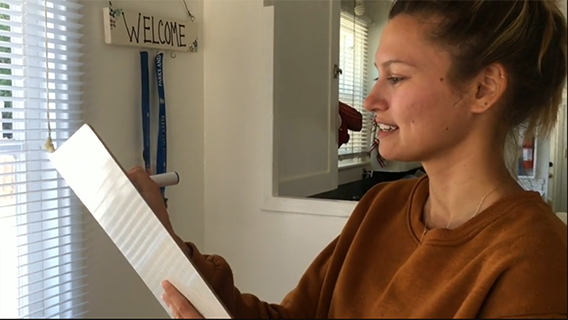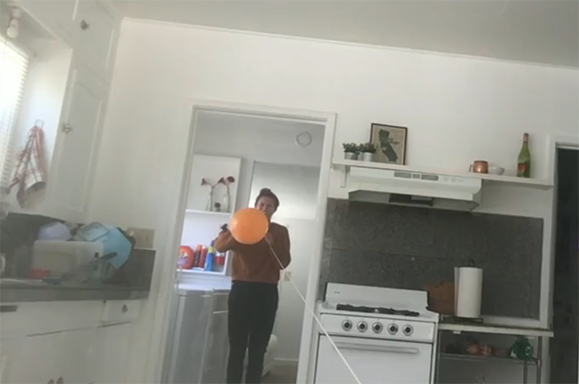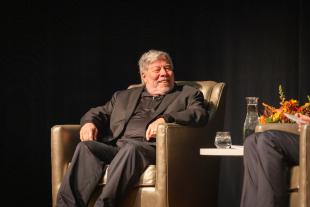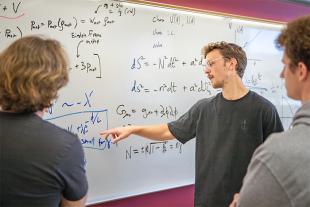'It Can Still Be Hands-On.' How This Ed Course Tackles Learning in a Virtual Environment
“On your marks, get set, go!”
A balloon shoots across a line that has been strung up across a living room, a bewildered dog watching from behind a chair. A student laughs in delight off-camera.
It’s a video of an assignment for professor Leah Wood’s EDUC 590 class: a rocket balloon challenge. It’s one of several hands-on lessons she’s assigned her students, who are completing the course virtually due to the coronavirus pandemic.
Her students work through the class assignments from the perspective of a learner, thinking critically about the barriers in the lesson and how they could adapt the lesson or find a new way to teach the concept for children with disabilities.
The Master’s-level special education course teaches education methods for science, social studies and engineering,
“I want them to Learn by Doing as a learner first,” Wood said. “The second big goal is taking that knowledge and using it as the foundation to engage in another type of Learn by Doing, which is creating tools to help students.”

At the beginning of the quarter, Wood mailed each of her students a small box with tools for different activities: a balloon and string for a balloon rocket challenge, rubber bands and pencils for a marshmallow shooter, and a tiny robot, called an Ozobot, that can be used to teach children how to code.
Wood included the Ozobots as a way to help her students develop a skills in coding, robotics and the engineering design process — and because the Ozobot company has a good grant-writing program, her students can write grants to get Ozobot sets for their own classrooms.
“They have this whole new skill set,” she said.
Wood is teaching the class asynchronously, which means that the class does not have a set meeting time every week.
“Part of this course is pushing them to be self-determined and exhibit the skills to be a lifelong learner,” Wood said. “Having less structure is intentional.”
Wood taught the class once before, in the spring of 2019, but the late start time meant that her students were coming in after a full day of classes at their student-teaching assignments.
The course has translated well to a virtual setting, and Wood said she’s seeing more engagement from her students as they work through the activities on their own time.
“They love doing activities in person, but it’s usually 7 at night and they’re exhausted,” Wood said. “I think this time, I’m seeing more overall engagement and satisfaction because they’re able to do it when they’re well-rested, want to do it and are ready to engage in that work.”
Wood said the virtual setting has been helpful in building more informative assessments for each of her students. For each online lesson, she makes a brief welcome video and models the type of activity they’re going to do for that week.
The students complete their activities and upload their written work and videos of the activities into an online program called Flipgrid. Wood gives them feedback through written comments, voice memos and videos.

“It’s really helped me realize that the whole class doesn’t have to be on the computer,” Wood said. “It can still be hands-on.”
Wood also encourages her class to think about what they would do next with the lesson, if they were teaching it to a student, and change variables in each activity to get different results.
“I want them to experience these Ozobots or make these marshmallow shooters and learn what it’s like to be the student who’s engaging in this activity,” Wood said. “That way, you can think from that perspective and identify barriers in the lesson, or things you love about it. I think there’s a benefit to giving future teachers the space to learn.”
Daniela Rothberg, one of Wood’s students, said she appreciates the way Wood has organized the course.
“Each week is different, and Flipgrid has been a great way to stay connected to the cohort,” Rothberg said. “You can see everyone and hear their opinion on the various topics we get.”
Wood said that while she misses her students and teaching in-person, the virtual setting has given her valuable insight.
“I don’t want to do it this way forever, but I think there are some real positives to take from this situation,” she said. “In the case of this course, some things are going really well.”




